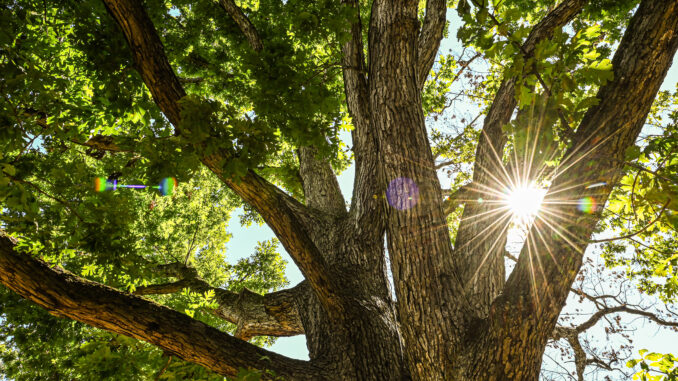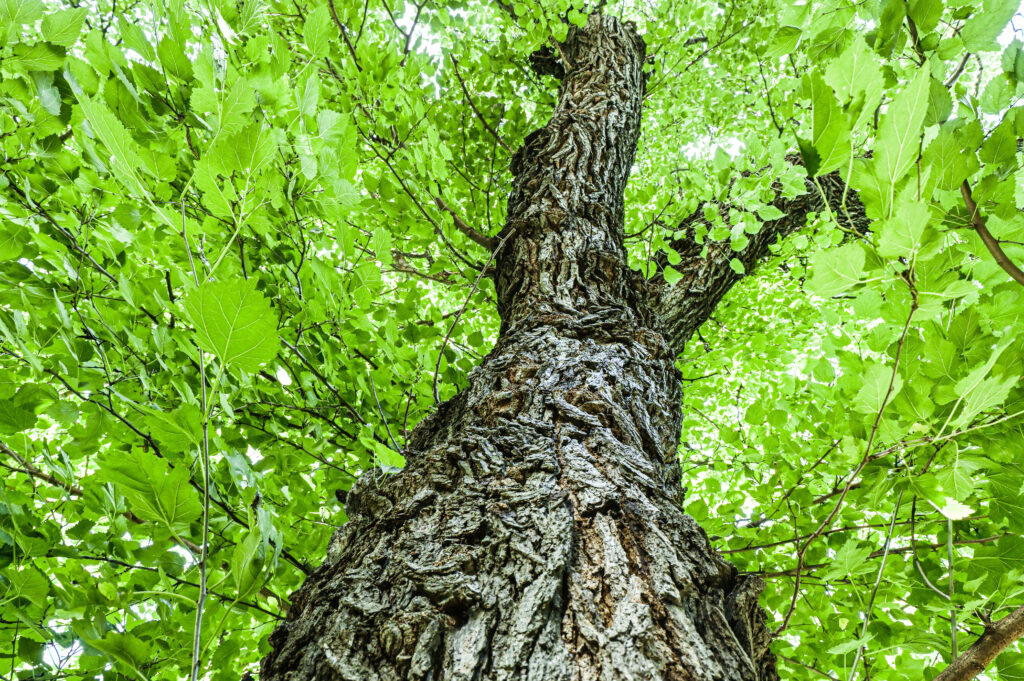
LIVING HISTORY
By Bill Kent
One of the oldest living things in Ashburn is dying.
The good news is that the 75-foot-tall, 300-year-old white oak that stands in the small recreation area off Ashburn Farm’s Gardengate Circle is taking its time (image at top).
Acorns, big rocks and a lone feather from a bird cover the ground around its massive trunk. Look up and you’ll see a wire going down its side that is intended to protect it from lightning strikes. Several large branches have been cut off, as part of the homeowners association’s plan to trim back dead wood with the hope that living areas will grow stronger and, possibly, resist the oak borer beetle that is trying to kill it.
So far, the beetle is winning, but the fight isn’t over.
This mighty oak – fighting to live after surviving since at least the 1700s – is just one example of the living history in the trees all around us.
There’s a towering buckeye near the Windmill Drive swimming pool in Ashburn Farm, one of its low-hanging limbs wrapped in yellow caution tape so passersby don’t bump into it. And a spectacular red mulberry off the W&OD trail sits next to the Ashburn Veterinary Hospital, with chickens pecking around on the ground below. These are just some of the local examples among the more than 1,500 trees on the Virginia Big Trees Registry.

The registry was started in 1970 and is run by Virginia Tech’s Department of Forest Resources and Environmental Conservation. Its mission is “to increase the care and appreciation of all trees – big and small – and educate the Commonwealth about the value of trees and forests.”
While some big trees – the types of granddaddies mentioned above – still loom in plain sight around Ashburn, arborist Jim Martin says there primarily are two kinds of trees in our community.
“You usually find older trees that have been here for about 50 years, and non-natives put in by developers and homeowners,” said Martin, co-owner of Growing Earth Tree Care, an Ashburn-based tree company.
Sadly, those non-natives can cause a lot of problems.
Take, for example, the Bradford Pear. Bred in China, it was approved as an ornamental tree by the U.S. Department of Agriculture over 50 years ago. That was just in time for the building boom that started in Ashburn in the 1980s. The Bradford Pear was one of several favorites of housing developers here because it grows rapidly and has a white, sweet-smelling spring bloom.
But because it is a soft-wooded tree, experts say, it is more likely to be blown apart in a strong wind or fall down from the weight of snow. They also say the many Bradford Pears in Ashburn are no friend to local wildlife – supporting relatively few birds and animals when compared with our native white oaks. A white oak can serve well over 450 species.
Many of the HOAs in the area are correcting these mistakes from before they took over their communities. Jason Mello, who serves on the Ashburn Village HOA board, says his community has made native flora a priority.
“In the last two years, Ashburn Village has planted over 300 native trees and plants in an effort to replace a large number [of non-natives] that have died due to disease or storm damage,” Mello said.
Regardless of age, any tree can be susceptible to the occasional blights. Like the oak borer, the emerald ash borer is another dangerous pest. A beetle native to Asia, it has forced arborists to cut down more than 1,000 ash trees locally in the past five years.

Circling back to our community’s history, the ash tree is the very species that, according to legend, inspired local landowner (and Virginia Del.) John Janney to name our town.
Yep – a supposed lightning strike setting an ash tree afire led to the name “Ashburn.” Despite the tale being widely retold, local historians say it is most likely not true.
Nothing remains of Janney’s home, which used to stand near Ashburn Lake off Ashburn Village Boulevard. But a few wooden structures from that era can still be found in the area.
One example is at One Loudoun in the community’s Central Park off Russell Branch Parkway.
A sign near a red barn in the park identifies it as once belonging to Charles Harris, an African-American farmer. Harris built the barn in 1875 from lumber cut from yellow pine trees growing on his Shellhorn Road farm. For more than a century, the barn stood near what is now an electric power substation near the Dulles Greenway.
In 2007, One Loudoun’s developers wanted a focal point for their new residential and retail community. They bought the barn and had historic preservation expert Allen Cochran help take it down, restore it and rebuild it to current standards. The work took seven years.
Modern building codes are part of the reason it took so long, said Cochran – who also restored the LeFevre stone farmhouse in Broadland’s Hillside Park. “We needed to make it code compliant,” he explained. “Working with an engineer, we couldn’t make the original pine timbers meet the required specs, so we had to move to a stronger wood.”
What did Cochran and his team choose? Oak.
They used lumber from local oaks that are in the same family as the 300-year-old oak along Gardengate Circle in Ashburn Farm – a bit of coming full circle – taking something old to make something new again.
Bill Kent is a prolific writer and author whose articles have appeared in The New York Times, the Philadelphia Inquirer, Kirkus Reviews and elsewhere.
